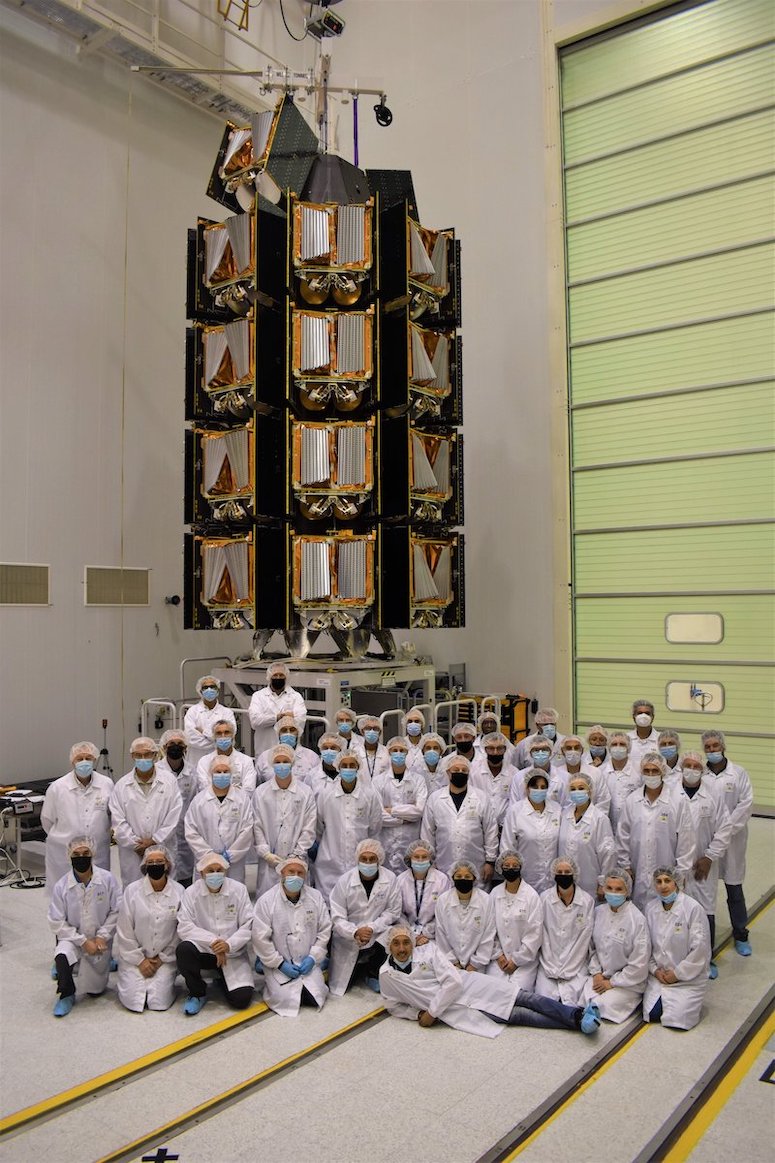
A Russian Soyuz rocket rolled out to a launch pad at the Baikonur Cosmodrome Monday, moving into position for liftoff Thursday with 34 more satellites for OneWeb’s broadband internet network.
Ground teams transferred the Soyuz-2.1b rocket from its hangar, known by the Russian acronym MIK, to the Site 31 launch complex at Baikonur.
With a Fregat upper stage and 34 OneWeb satellites enclosed in its payload fairing, the Soyuz launcher rode a rail car to the launch pad at the Russian-operated spaceport in Kazakhstan. Once at the pad, the rocket was raised vertical and gantry arms rotated into position around the launcher.
Work planned over the next few days include final inspections of the launch vehicle, configuring of the first stage engine ignitor system, and removal of the thermal blanket covering the Soyuz payload fairing.
On Thursday, Russian managers are expected to give approval to load kerosene and liquid oxygen propellants into the Soyuz rocket. The countdown Thursday will target liftoff at 6:23 p.m. EDT (2223 GMT).
The launch Thursday will bring OneWeb’s satellite fleet to 288 spacecraft. It will be the ninth dedicated launch for OneWeb since February 2019. All of OneWeb’s launches to date have used Russian-built Soyuz rockets under a commercial contract arrangement with Arianespace, the French launch services company.

Each OneWeb satellite is about the side of a mini-fridge. The spacecraft are built by OneWeb Satellites, a joint venture between OneWeb and Airbus, in a factory just outside the gate of NASA’s Kennedy Space Center in Florida.
The OneWeb satellites beam broadband internet signals to users on the ground, at sea, or in the air, providing high-speed, low-latency connectivity for consumers, large companies, and governments. OneWeb is competing with SpaceX’s Starlink network, along with planned internet constellations from other companies.
SpaceX has launched 1,740 Starlink satellites to date, enough to complete the build-out of the first of five planned orbital “shells” envisioned to complete the network, which could eventually number 12,000 spacecraft. After a break of more than two months between Starlink missions, SpaceX is expected to resume Starlink launches using Falcon 9 rockets in September.
OneWeb’s constellation needs fewer satellites to provide global internet service. The London-based operator plans to deploy 648 spacecraft through next year, including spares.
The Soyuz launches for OneWeb can take off from three different spaceports. So far, one Soyuz launch for OneWeb has launched from the Guiana Space Center in South America, two have departed from Baikonur, and five have lifted off from the Vostochny Cosmodrome in Russia’s Far East.
The most recent launch for OneWeb on July 1 gave the company enough spacecraft to provide internet services to customers north of 50 degrees latitude.
OneWeb filed for bankruptcy in March 2020 after failing to secure enough funding to continue building and launching satellites. The reorganized company emerged from bankruptcy last year under the ownership of Bharti Global and the UK government.
OneWeb announced Aug. 12 a $300 million equity investment from Hanwha, a South Korean tech and manufacturing firm. The funding brings the total equity investment in OneWeb since November 2020 to $2.7 billion, the company said.

The Soyuz rocket launching Thursday will blast off with more than 900,000 pounds from 32 engine nozzles, driving the launcher toward the north from Baikonur. Within two minutes, four liquid-fueled first stage boosters will shut down and jettison, and the Soyuz core stage will switch off and separate nearly five minutes after liftoff.
Moments after the third stage engine ignites, the Soyuz willl shed its clamshell-like aerodynamic payload shroud. The third stage will deploy a Fregat upper stage on a preliminary suborbital trajectory more nine minutes into the mission, completing the role of the Soyuz rocket for the mission.
The main engine of the Fregat upper stage will ignite two times to place the 34 OneWeb satellites into a targeted polar orbit roughly 280 miles (450 kilometers) above Earth, with an inclination of 87.4 degrees to the equator.
Then begins a series of deployments to release the 34 OneWeb satellites from a composite dispenser, or connecting interface, made by RUAG Space in Sweden.
First, two of the 325-pound (147.5-kilogram) satellites will separate from the top of the cluster. The remaining 32 spacecraft will separate in groups of four at intervals of approximately 20 minutes, with maneuvers by the Fregat’s smaller attitude control thrusters in between to ensure the satellites did not collide.
The satellite separation events will largely occur when the Fregat is flying outside the range of ground tracking stations, so confirmation of some of the spacecraft deployment milestones will be delayed.
The last group of OneWeb satellites will release from the Fregat’s dispenser around 3 hours, 45 minutes into the mission.
The OneWeb satellites will use their on-board xenon propulsion systems to raise their altitude to enter the company’s operational constellation 745 miles (1,200 kilometers) above Earth.
Email the author.
Follow Stephen Clark on Twitter: @StephenClark1.
